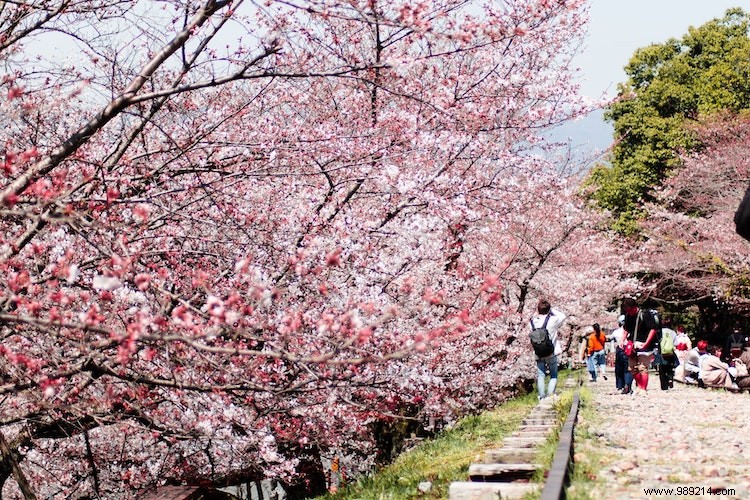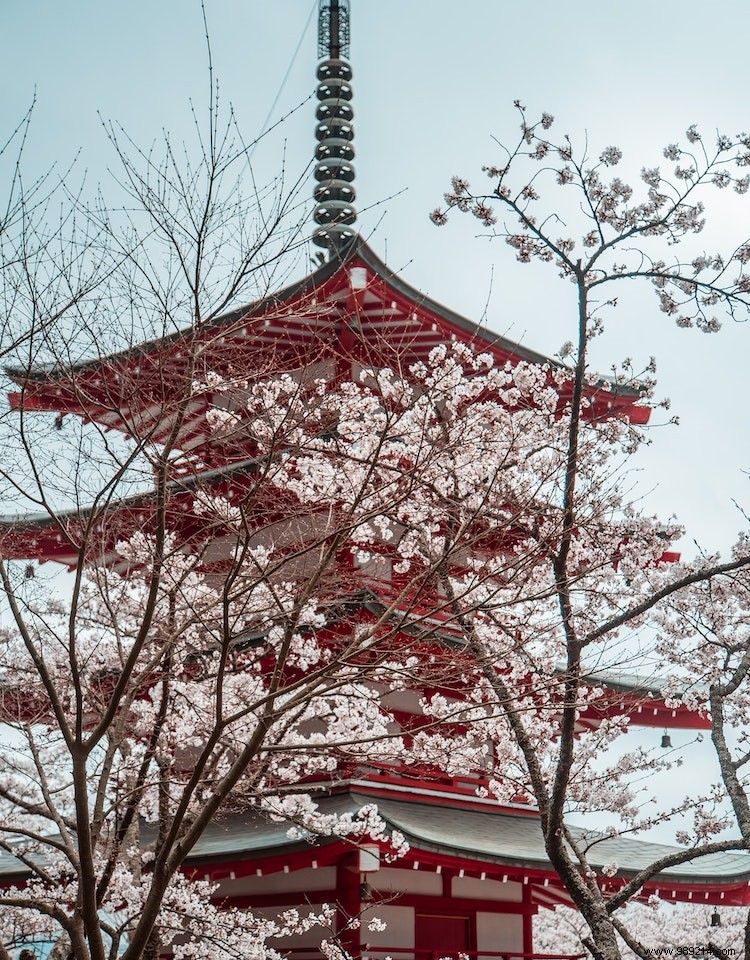Cherry blossoms—known in Japanese as "sakura"—are the country's most anticipated and arguably best-loved flower. The enchanting flowers have come to embody the wabi-sabi philosophy; the appreciation for the ephemeral and the Shinto ideals of hope and renewal. When the days warm up and the soft pink petals appear, people come from far and wide to glimpse this enchanting flower and celebrate by throwing hanami (flower watching) parties.
A Brief History of Cherry Blossoms
The arrival of cherry blossoms has been an important event on Japan's seasonal calendar since ancient times. Initially, the plum blossom was recognized and revered as the flower symbol of spring. During the Nara period (710-794), admirers flocked to the parks in March and April to admire the blooming plum blossoms, and later during the Heian period (794-1185), cherry blossoms became more synonymous with hanami celebrations within aristocratic circles. . By the Edo period (1603-1868), which was a prime time for Japan's cultural evolution, flower viewing parties (hanami celebrations) spread to the wider public. The hanami celebrations that many people enjoy today have their roots in the mid-17th century. One of the earliest public-style hanami events was held in Ueno, Tokyo, which remains an incredibly popular hanami destination in Tokyo to this day, thanks to its large population of sakura trees and wide-open space.

The many types of blossoms
Surprisingly, cherry blossoms are as diverse as they are beautiful. There are over 100 different varieties of cherry blossom trees in Japan alone. Of all the varieties, the Somei Yoshino, also known as the Yoshino cherry, is the most common. Other notable variations include the weeping cherry, equinoctial cherry, and Shibazakura. While most cherry blossoms have been cultivated by humans for decoration, there are a handful of wild varieties that bloom in the forests of Japan. In addition to white or pink cherry blossom varieties, you can also find dark pink, yellow or green blossoms all over Japan. And while most flowers have five petals, there are varieties with more than five, they are known as yaezakura.
Peak sakura season on the map The peak cherry blossom season lasts only for a fleeting moment, which is why it is such an expected time. The first flowers start in the south in the warmer parts of Japan such as Nagasaki and Kagoshima and in central Honshu; Tokyo, Osaka, Kanazawa, usually mid-late March, while peak season is in April. In the cooler areas of the country, such as Sapporo and Aomori, blossoms appear in mid-April. While that's the usual schedule, the season can start earlier or later depending on how warm the year is, warmer months mean earlier blossoms. Although not known as a popular sakura viewing area, in Okinawa flowers first appear in January!

Hanami parties, picnics in the park
Hanami celebrations are the most popular way for people to make the most of the cherry blossom season. The term "hanami" means flower - "hana" looking - "mi", and it's really just an excuse to get outside, enjoy the warmer weather and catch up with friends and colleagues. Hanami celebrations usually consist of picnics in the park and they can be as casual or extravagant as you like. As long as you have a picnic blanket, food, drink, good company and a good spot under a local cherry blossom tree, you'll get all the essential ingredients for a perfect hanami party.
Mt Fuji, one of the most iconic viewing locations
In addition to parks, many people flock to popular landmarks to see the cherry blossoms in full bloom. One of the most spectacular views not far from Tokyo is Arakurayama Sengen Park in Yamanashi Prefecture. From Tokyo, it takes about two to two and a half hours to get there by public transportation, but the view of Mt. Fuji, and the vibrant five-story red pagoda framed by the soft bubblegum pink of the cherry blossoms, is a sight well worth the trip. After the peak season of the Yoshino variety of cherry blossoms, Yamanashi also hosts the Shibazakura festival. Shibazakura, also known as moss phlox or grass cherry, is a vibrant pink and covers the ground like a lawn. The festival site is located near the Fuji Five Lakes area. Here you can witness the dramatic and photogenic sight of the Shibazakura field in the foreground and Mt. Fuji, in the back. The event will be held around Golden Week.

Captivating castle blossoms The Japanese castle towns are especially beautiful during the cherry blossom season, as the soft flowers seem to contrast the hard, traditional wooden and stone architecture of the national castles and their ruins. At the base of Toyama Castle is a cluster of approximately 470 cherry blossom trees that line the banks of the Matsukawa. Next to the river is a walking path, the perfect place to walk under the cherry blossom trees in full bloom, you can admire them from a different perspective on a boat cruise. Two other legendary castle sites with plenty of sakura trees to admire are the World Heritage-listed Himeji Castle in Hyogo Prefecture, which hosts a Cherry Blossom Visiting Festival, and Kanazawa Castle in Ishikawa Prefecture, which showcases an impressive illuminated nighttime view.
Don't miss the late blooming Tohoku blossoms
If you miss the peak season in central Honshu, you can always make the trip north to the Tohoku region to enjoy the country's later blooming blossoms. In the prefecture of Fukushima you will find the Miharu Takizakura, one of the three largest cherry blossom trees in Japan. In 1922, this tree was also the first sakura tree to be designated as a national treasure. It is estimated to be over 1000 years old and gets its name from the fact that when in full bloom it resembles a waterfall (which is "taki" in Japanese). During the season, approximately 300,000 guests flock to the area to see the legendary tree in all its glory. Located in Iwate Prefecture, Kitakami Tensuchi Park is known as one of the 100 best cherry blossom viewing spots in Japan and one of the three major Sakura famous places in Michinoku. Here you will find about 10,000 trees spread over about 150 species of sakura, including the Beniyama cherry trees that bloom in early May.